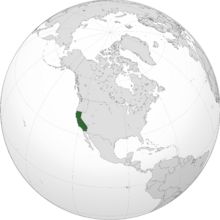New California
Socialist Republic of New California | |
|---|---|
| Motto: "Eureka" | |
| Anthem: "I Love You, California" | |
 | |
| Capital | Sacramento |
| Largest city | Los Angeles |
| Official languages | English |
| Recognised regional languages | Spanish |
| Ethnic groups (2040) | By race:
|
| Religion (2044) |
|
| Demonym(s) | Californian |
| Government | Federal presidential republic |
| Tia Ferch | |
| Francisco García-Pérez | |
| Tramell Stewart | |
| Jon Young | |
| Legislature | Congress |
| Senate | |
| General Assembly | |
| Independence from United States | |
| October 19, 2031 | |
| February 16, 2032 | |
| September 3, 2037 | |
| June 1, 2043 | |
| Area | |
• Total | 423,970 km2 (163,700 sq mi) (59th) |
• Water (%) | 4.7 |
| Population | |
• 2048 estimate | 48,826,640 (31st) |
• 2045 census | 48,088,425 |
• Density | 115.1/km2 (298.1/sq mi) (75th) |
| GDP (nominal) | 2040 estimate |
• Total | $9.6 trillion |
• Per capita | $169,662.50 |
| Gini (2040) | low |
| HDI (2040) | very high (15th) |
| Currency | Californian Dollar (NCD) |
| Time zone | UTC-8 |
| Driving side | right |
| Calling code | +1 |
| ISO 3166 code | NS |
| Internet TLD | .ns |
New California, officially the Socialist Republic of New California and commonly known as California, is a country located in western North America, bordered by Willamette to the north, the Reformed States of America to the east, and Mexico to the south. It is a federation of 58 counties and 697 communes. The country has the world's 15th-highest Human Development Index score and one of the world's largest economies.
Native Americans solely inhabited California from roughly 12,000 years ago until 1769, when the Spanish Empire took over the land. The United States acquired ownership of the land in 1848 with the Treaty of Guadalupe Hidalgo. The California Gold Rush started in 1848 and led to dramatic social and demographic changes, including the depopulation of indigenous peoples in the California genocide. The western portion of Alta California was then organized and admitted as the 31st state on September 9, 1850, as a free state, following the Compromise of 1850. California seceded from the United States following the United States Term Limits Act of 2031, and was officially constituted in 2032. The Treaty of Carson City formally recognized New California as a sovereign state.
The nation's extremely diverse geography ranges from the Pacific Coast and metropolitan areas in the west to the Sierra Nevada mountains in the east, and from the redwood and Douglas fir forests in the northwest to the Mojave Desert in the southeast. New California is known for being extrememly prone to earthquakes. The Central Valley, a fertile agricultural area, dominates the state's center. New California is well known for its warm Mediterranean climate along the coast and monsoon seasonal weather inland. The large size of the natom results in climates that vary from moist temperate rainforest in the north to arid desert in the interior, as well as snowy alpine in the mountains. Droughts and wildfires are an ongoing issue for the nation. New California is a member of NATO, despite not touching the Atlantic Ocean, which caused some controversy in 2039. The nation is also a founding member of the Pacific League, along with Willamette and the Hawaii Republic.

